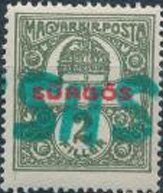Stamp: Delivery Stamp (Croatia - Kingdom of Serbs, Croats & Slovenes 1919)
Delivery Stamp (Croatia - Kingdom of Serbs, Croats & Slovenes 1919)
01 January (Croatia - Kingdom of Serbs, Croats & Slovenes ) within release Local issue for Beltinci (Belatinc) goes into circulation Stamp Delivery Stamp face value 2 Hungarian fillér
| Stamp Delivery Stamp in catalogues | |
|---|---|
| Philatelia Hungarica Catalog: | PHu: HU-BEL 1 |
Stamp is vertical format.
This serie was printed by croat troops after occupying Belatinc village. Michel catalog lists the full serie without giving unique numbers to the stamps. Michel catalog identifies the overprint color as green blue, while HUN philatelia recognises as seagreen. Hand made poor SHS overprint on Mi: HU 180.Also in the issue Local issue for Beltinci (Belatinc):
- Stamp - Delivery Stamp face value 2;
- Stamp - King Charles IV (1887-1922) face value 10;
- Stamp - King Charles IV (1887-1922) face value 20;
- Stamp - King Charles IV (1887-1922) with "Republic" Overprint face value 15;
- Stamp - Parliament Building, Budapest face value 50;
- Stamp - Parliament Building, Budapest face value 75;
- Stamp - Parliament Building, Budapest face value 80;
- Stamp - Parliament Building, Budapest face value 1;
- Stamp - Parliament Building, Budapest face value 2;
- Stamp - Parliament Building, Budapest with "Republic" overprint face value 1;
- Stamp - Reaper face value 3;
- Stamp - Reaper face value 10;
- Stamp - Reaper face value 20;
- Stamp - Reaper face value 25;
- Stamp - Reaper face value 6;
- Stamp - Reaper face value 15;
- Stamp - Reaper face value 35;
- Stamp - Reaper Inscribed Magyar Kir. Posta face value 2;
- Stamp - Reaper Inscribed Magyar Kir. Posta face value 5;
- Stamp - Reaper Inscribed Magyar Kir. Posta face value 40;
- Stamp - Reaper Inscribed Magyar Posta face value 2;
- Stamp - Reaper Inscribed Magyar Posta face value 5;
- Stamp - Reaper with "Republic" overprint face value 5;
- Stamp - Reaper with "Republic" overprint face value 40;
Stamp Delivery Stamp it reflects the thematic directions:
In British heraldry, a coronet is any crown whose bearer is less than sovereign or royal in rank, irrespective of the crown's appearance. In other languages, this distinction is not made, and usually the same word for crown is used irrespective of rank (German: Krone, Dutch: Kroon, Swedish: Krona, French: Couronne, etc.) In this use, the English coronet is a purely technical term for all heraldic images of crowns not used by a sovereign, and implies nothing about the actual shape of the crown depicted. A Coronet is another type of crown, but is reserved for the lower ranks of nobility like Marquesses and Marchionesses, Earls and Countesses, Barons and Baronesses, and some Lords and Ladies. The specific design and attributes of the crown or coronet signifies the hierarchy and ranking of its owner.
A number is a mathematical object used to count, measure, and label. The most basic examples are the natural numbers 1, 2, 3, 4, and so forth. Numbers can be represented in language with number words. More universally, individual numbers can be represented by symbols, called numerals; for example, "5" is a numeral that represents the number five. As only a relatively small number of symbols can be memorized, basic numerals are commonly organized in a numeral system, which is an organized way to represent any number. The most common numeral system is the Hindu–Arabic numeral system, which allows for the representation of any non-negative integer using a combination of ten fundamental numeric symbols, called digits. In addition to their use in counting and measuring, numerals are often used for labels (as with telephone numbers), for ordering (as with serial numbers), and for codes (as with ISBNs). In common usage, a numeral is not clearly distinguished from the number that it represents.


